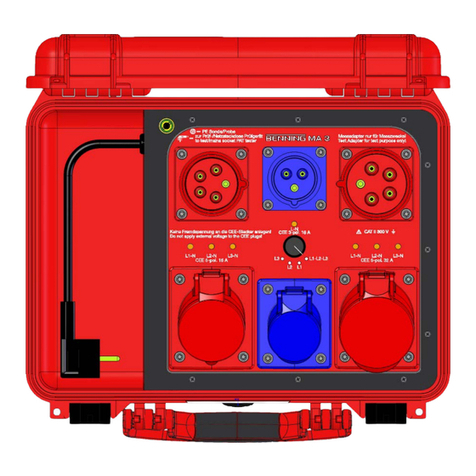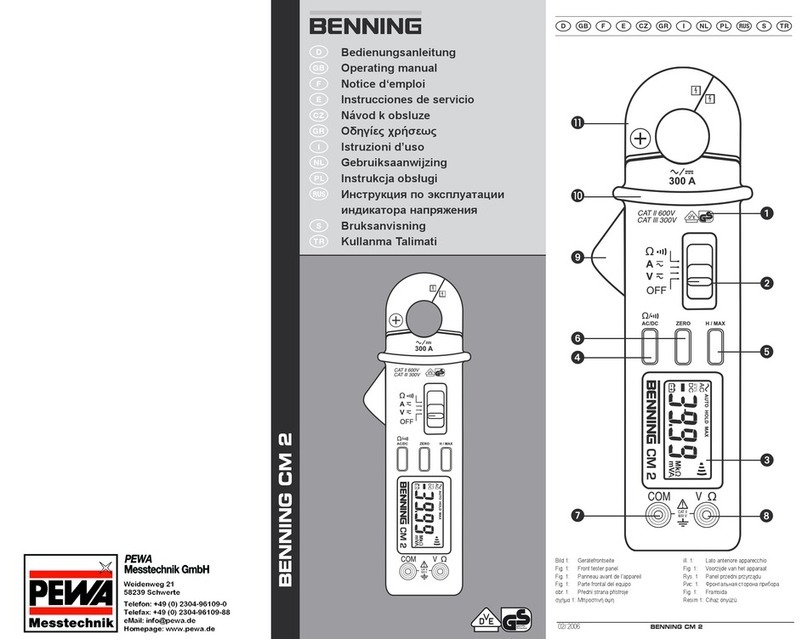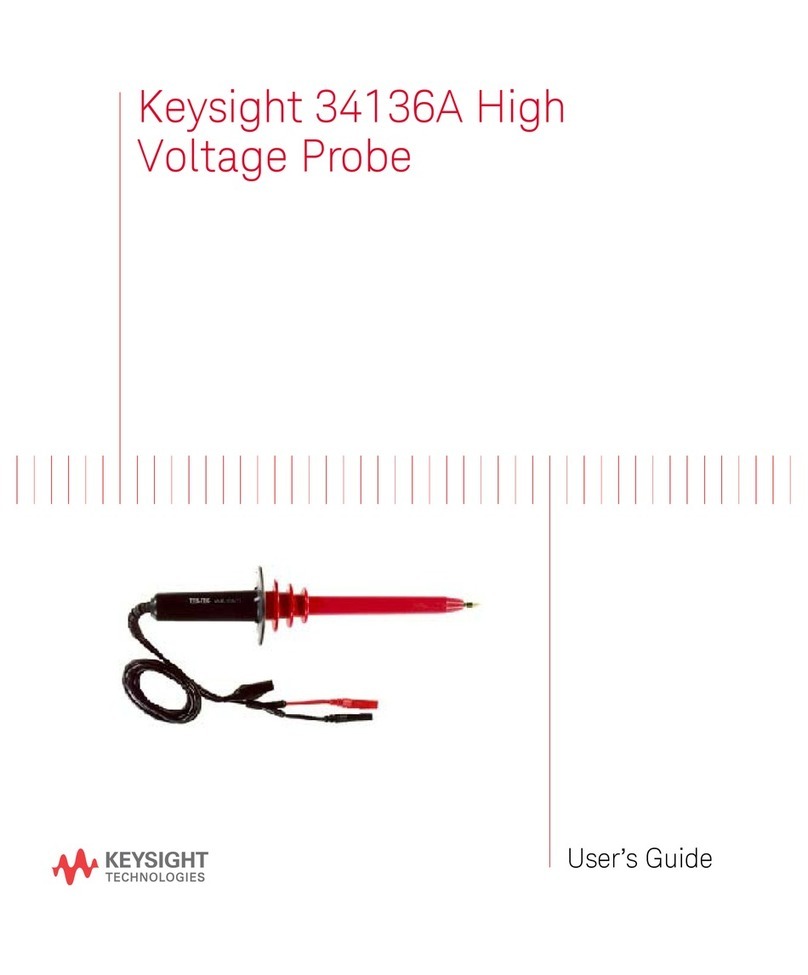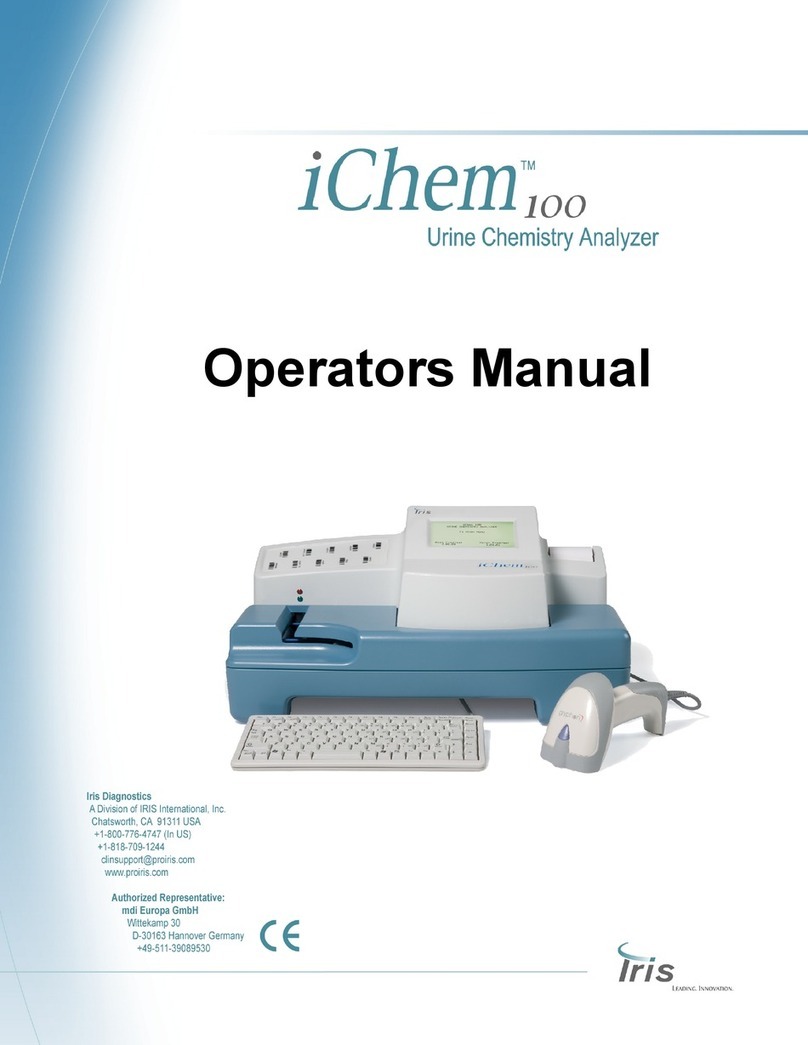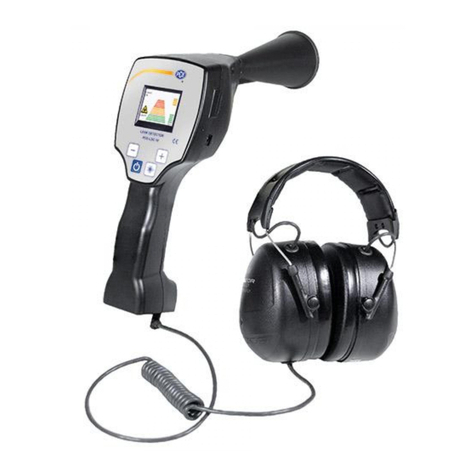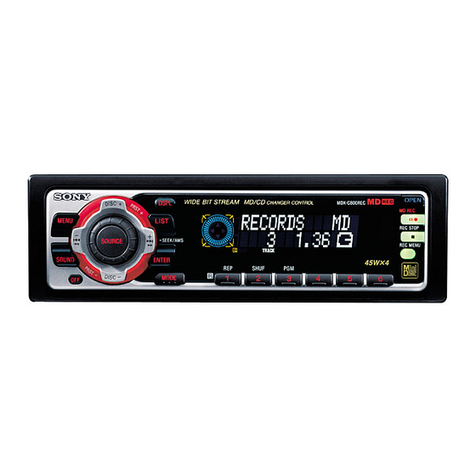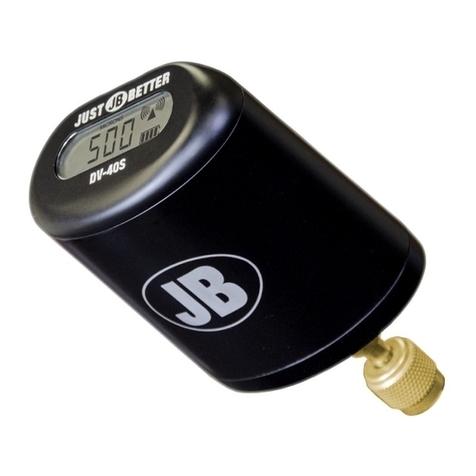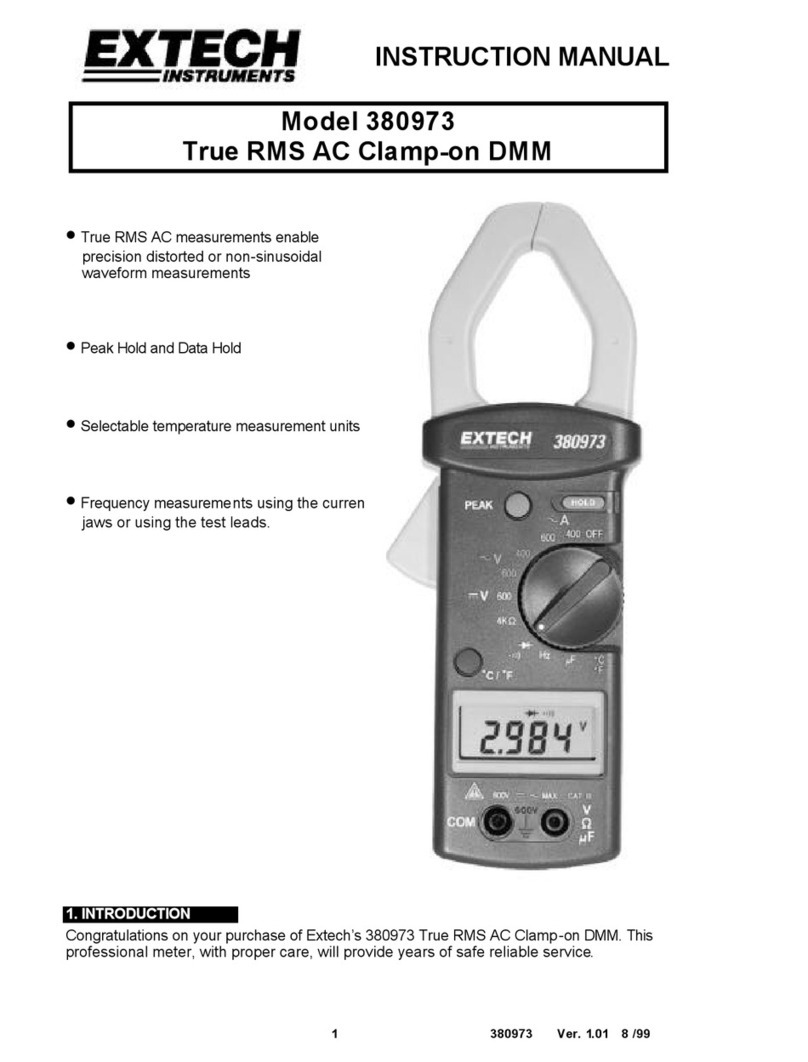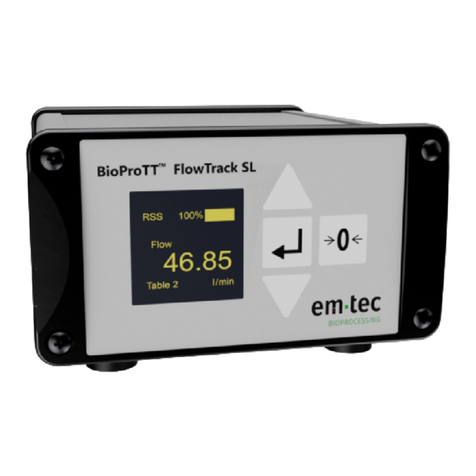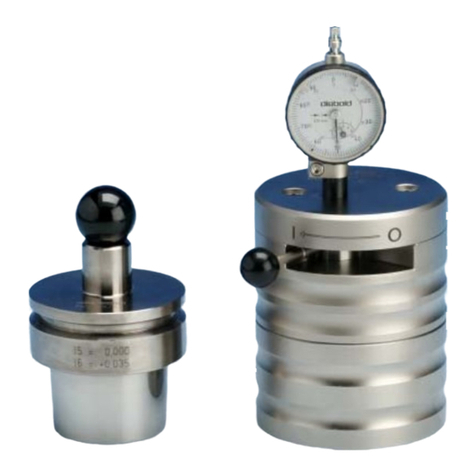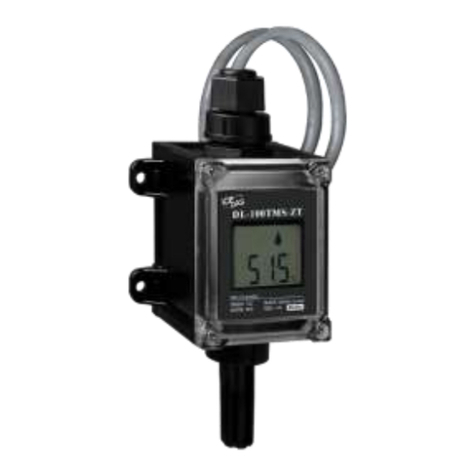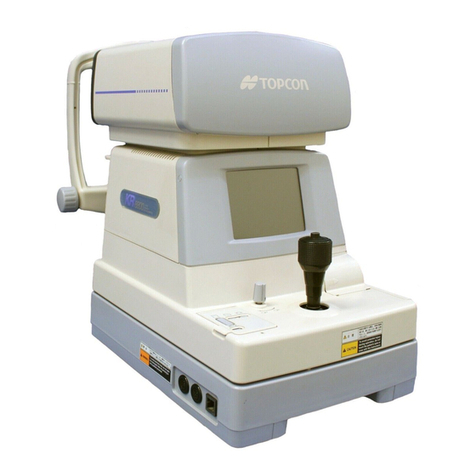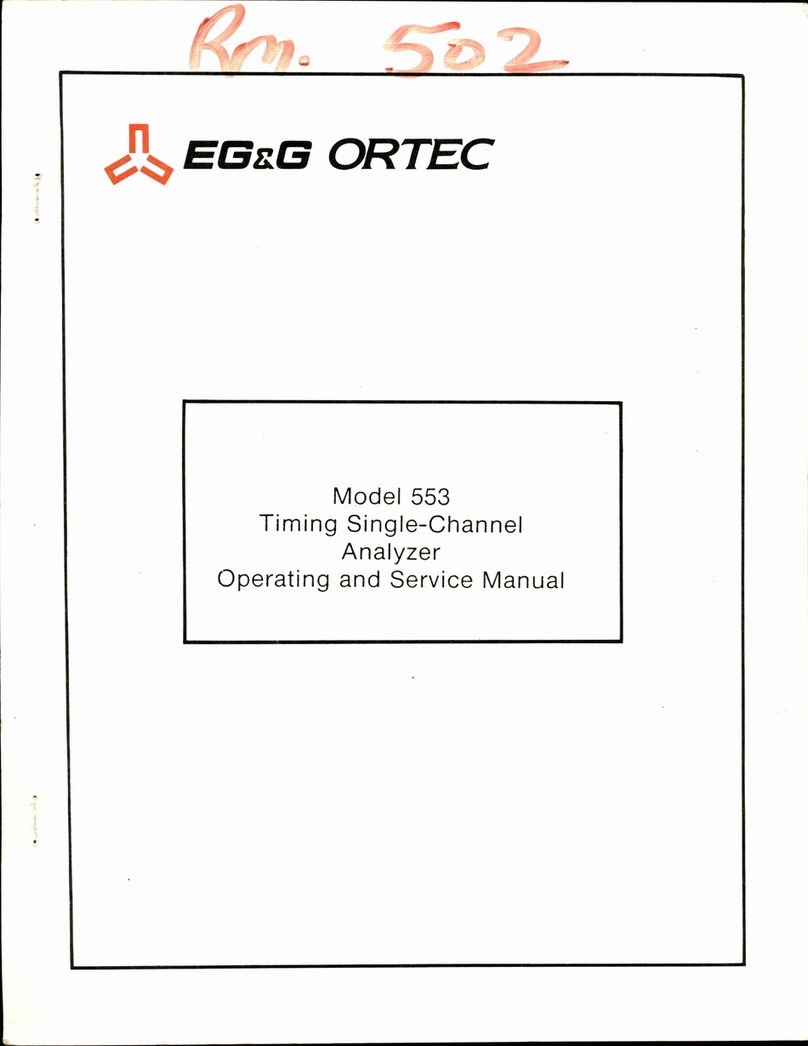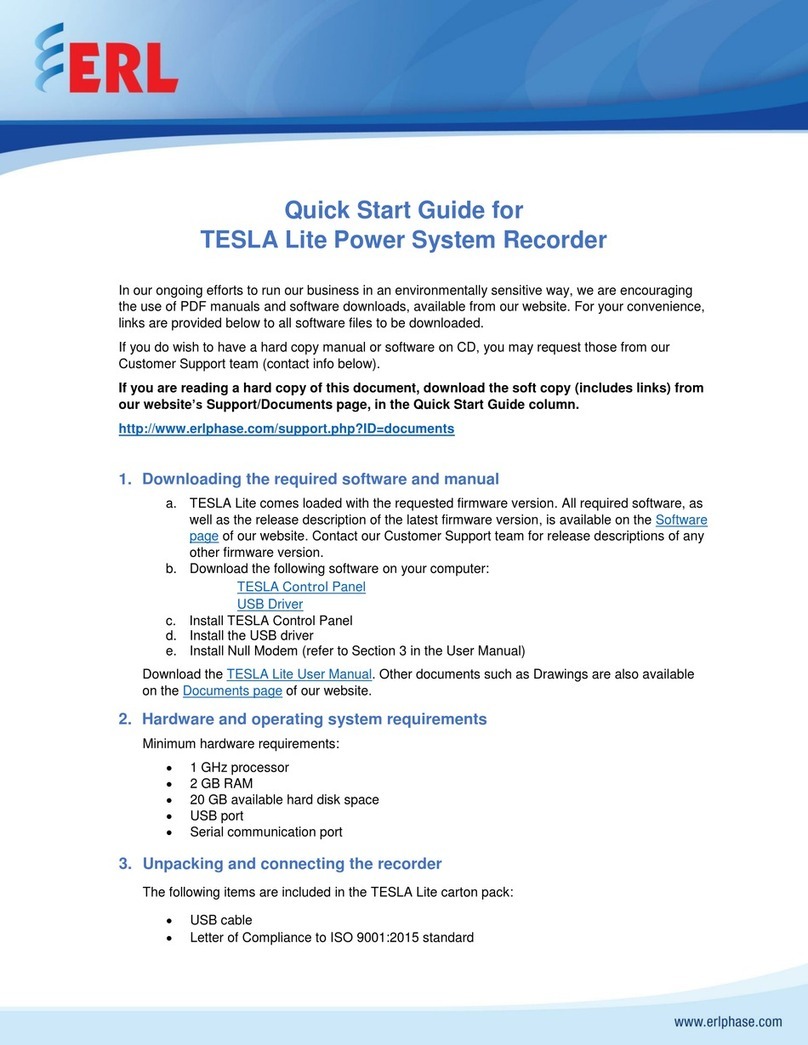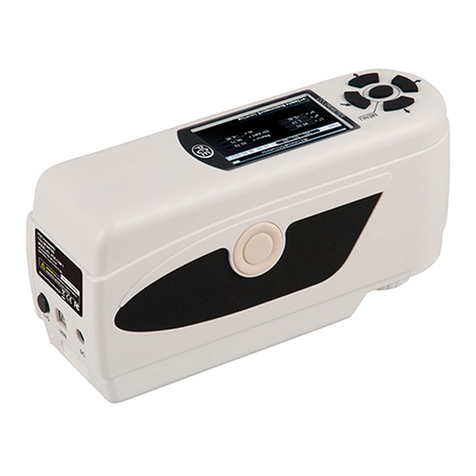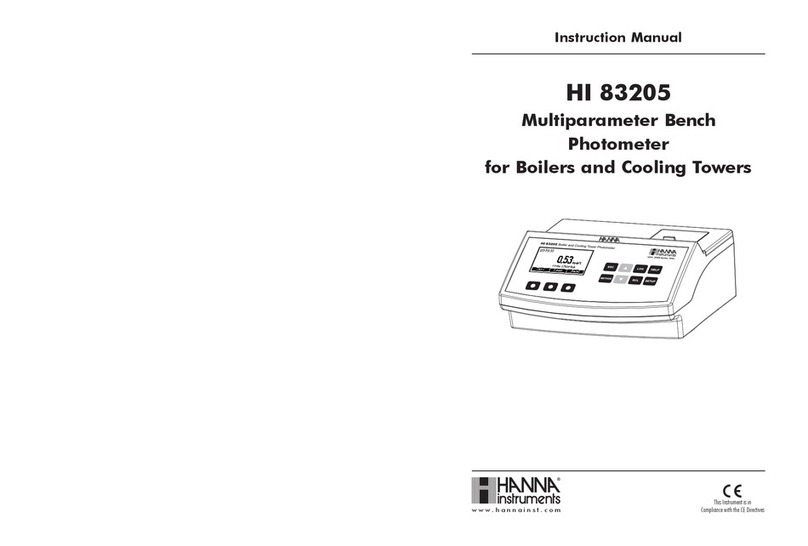Benning VT 2 User manual

BENNING VT 2
DBedienungsanleitung
Operating manual
FMode d‘emploi
Návodkpoužitízkoušečky
Käyttöohje
Οδηγίεςχρήσεως
IIstruzioniperl’uso
Gebruiksaanwijzing
Instrukcjaobsługi

BENNING VT 2
Mehrsprachige Anleitung unter
www.benning.de
Multilingual manuals at
DBedienungsanleitung
Operating manual
FMode d‘emploi
Gebruiksaanwijzing

09/ 2020
BENNING VT 2
3
D F I
A
2
1
66
5
4
3
7 7

09/ 2020
BENNING VT 2
4
D F I
230 VAC
PE
N L
B
C
LED: rot/red
LED: rot/red

09/ 2020
BENNING VT 2
5
D F I
D
LED: grün/green

09/ 2020
BENNING VT 2
6
D
Bedienungsanleitung
BerührungsloserPhasen-undMagnetfeldprüfer
BENNING VT 2
Bevor Sie den Phasen-/ Magnetfeldprüfer BENNING VT 2 benutzen: Lesen Sie bitte die Bedienungs-
anleitung und beachten Sie unbedingt die Sicherheitshinweise!
1. Sicherheitshinweise:
Achtung! Magnete können die Funktion von Herzschrittmachern und implantierten
Defibrillatorenbeeinflussen.HaltenSiealsTrägersolcherGeräteeinengenügenden
AbstandzudemMagnetenein.
- Unmittelbar vor und nach dem Benutzen den Phasen-/ Magnetfeldprüfer auf Funktion prüfen (siehe
Abschnitt 3)! Das Gerät darf nicht benutzt werden, wenn die Funktion einer oder mehrerer Anzeigen
ausfällt oder keine Funktionsbereitschaft zu erkennen ist!
- Gerät beim Prüfen nur an dem roten Griff hinter der Griffbegrenzung
2
anfassen und die weiße
Prüfspitze
1
nicht berühren!
- Das Gerät darf nur im angegebenen Nennspannungsbereich von 12 V - 1000 V AC und in geerde-
ten Netzstromkreisen der Überspannungskategorie CAT III 1000 V bzw. CAT IV 600 V Leiter gegen
Erde benutzt werden.
- Der Phasen-/ Magnetfeldprüfer BENNING VT 2 erkennt elektrische Felder von Spannungen ab ca.
12 V/ 200 V Wechselspannung (AC). Felder von Gleichspannungen (DC) werden nicht erkannt!
-
Beachten Sie, dass Arbeiten an spannungsführenden Teilen und Anlagen grundsätzlich gefährlich
sind. Bereits Spannungen ab 30 V AC und 60 V DC können für den Menschen lebensgefährlich sein.
- Der Phasen-/ Magnetfeldprüfer BENNING VT 2 ist kein Ersatz für einen zweipoligen Spannungs-
prüfer z. B. DUSPOL
®
, um das Feststellen der Spannungsfreiheit zu bestimmen.
- Folgende Faktoren können die korrekte Funktionsweise der Phasen-/Außenleiterpüfung negativ
beeinflussen:
- zu großer Abstand zur prüfenden Phase (Außenleiter)
- zu starke Isolierung und Abschirmung der Phase (Außenleiter)
- Schutzkleidung und isolierende Standortgegebenheiten
- konstruktive Unterschiede von Steckdosen/ CEE-Kupplungen mit zurückliegenden Kontakten,
z.B. 63 A CEE-Kupplung
- Netzstörungen oder mangelnde Netzqualität
- Zustand der im Phasen-/ Magnetfeldprüfer BENNING VT 2 eingelegten Batterien
- Gerät nicht mit geöffnetem Batterieschacht betreiben.
- Das Gerät ist für die Anwendung durch Elektrofachkräfte in Verbindung mit sicheren Arbeitsverfah-
ren ausgelegt.
- Das Gerät ist vor Verunreinigungen und Beschädigungen der Gehäuseoberfläche zu schützen.
- Ist anzunehmen, dass ein gefahrloser Betrieb nicht mehr möglich ist, ist das Gerät außer Betrieb zu
setzen und gegen unbeabsichtigten Betrieb zu sichern.

09/ 2020
BENNING VT 2
7
D
Elektrische Symbole auf dem Gerät:
Symbol Bedeutung
Achtung! Magnete können die Funktion von Herzschrittmachern und implantierten
Debrillatoren beeinussen. Halten Sie als Träger solcher Geräte einen genügenden
Abstand zu dem Magneten ein.
mAchtung Dokumentation beachten!
Das Symbol gibt an, dass die Hinweise in der Bedienungsanleitung zu beachten sind,
um Gefahren zu vermeiden
Dieses Symbol auf dem Gerät bedeutet, dass der BENNING VT 2 schutzisoliert
(Schutzklasse II) ausgeführt ist.
Bedienungsanleitung beachten.
Dieses Symbol auf dem Gerät bedeutet, dass das Gerät konform zu den EU-Richtlinien
ist.
AC Wechselspannung
Erde (Spannung gegen Erde)
Dieses Symbol zeigt die Ausrichtung der Batterien zum polrichtigen Einlegen an
2. Gerätebeschreibung(Bild A)
1PrüfspitzemitLED-Anzeige (rot/grün)
2Griffbegrenzung
3
H
LED(rot), Anzeige für hohe Empndlichkeit (Erfassung elektrischer Felder von Spannungen
ab ca. 12 V AC)
4Taster (blau), zur Aktivierung der hohen Empndlichkeit (Erfassung elektrischer Felder von Span-
nungen ab ca. 12 V AC)
5Clip
6Batteriefachdeckel
7Testmagnet
3. Funktionsprüfung
- Unmittelbar vor und nach dem Benutzen den Phasen-/ Magnetfeldprüfer auf Funktion prüfen!
- Testen Sie die Funktion der Phasenprüfung an einer bekannten Spannungsquelle z.B. 230 V
Steckdose.
- Testen Sie die Funktion der Magnetfeldprüfung an dem integrierten Testmagneten 7. Der Testma-
gnet kann von dem Batteriefachdeckel 6abgeschraubt werden.
- Der Batteriewechsel ist erforderlich, wenn die rote/grüne LED-Anzeige 1oder der Signalton
schwach werden.
- Verwenden Sie den BENNING VT 2 nicht, wenn nicht alle Funktionen einwandfrei funktionieren!
- Der BENNING VT 2 besitzt keinen Ausschalter und ist immer aktiv. Eine spezielle Schaltung mit
geringer Stromaufnahme verlängert die Batterielebensdauer und somit Einsatzbereitschaft.

09/ 2020
BENNING VT 2
8
D
4. Funktionsweise
Anzeige von elektrischen Feldern:
- Der Phasen-/ Magnetfeldprüfer BENNING VT 2 erkennt elektrische Felder, die von Phasen-/ Au-
ßenspannungen ab 200 V - 1000 V AC (45 - 65 Hz) erzeugt werden. Eine Umschaltfunktion erhöht
die Empndlichkeit, so dass elektrische Felder von Spannungen ab ca. 12 V AC oder höher er-
kannt werden.
- Wird ein elektrisches Feld erfasst, leuchtet die Prüfspitze 1rot auf und ein Signalton ertönt. Die
Blinkfrequenz der roten Prüfspitze 1 und die Signaltonfrequenz steigt mit zunehmender Höhe des
elektrischen Feldes bzw. der anliegenden Spannung.
- Der Phasen-/ Magnetfeldprüfer BENNING VT 2 kann benutzt werden, um die Phase (Außenleiter)
einer Wechselspannung zu bestimmen.
- Für die Prüfung ist kein Stromuss und keine elektrisch leitende Kontaktierung mit dem Anlageteil,
der Steckdose oder der isolierten Leitung nötig.
- Beachten Sie, dass der BENNING VT 2 ohne Betätigung des Taster 4nur auf ausreichend starke
Felder ab 200 V AC Phasen-/ Außenleiterspannung reagiert.
Sollte der Phasen-/ Magnetfeldprüfer BENNING VT 2 nicht reagieren, könnte der Abstand zum span-
nungsführenden Anlageteil zu groß sein oder das Anlageteil ist abgeschirmt bzw. die Isolierung ist zu
dick.
Anzeige von magnetischen Feldern:
- Der Phasen-/ Magnetfeldprüfer BENNING VT 2 erkennt ausreichend starke magnetische Felder
die von elektromagnetischen Schaltern (Schützen/ Relais) und Ventilen (Magnetventilen) erzeugt
werden. Erfasst werden Permanent-, Gleich- und Wechselstrommagnetfelder.
- Wird ein magnetisches Feld erfasst, leuchtet die Prüfspitze 1grün auf.
5. Phasen-/AußenleiterprüfungeinerWechselspannung(Bild B)
- Positionieren Sie die Prüfspitze 1an die vermutete Phase (Außenleiter) des Anlageteils.
- Das Anliegen der Phase (Außenleiter) wird über ein Signalton und das rote Aueuchten der Prüf-
spitze 1angezeigt.
- Durch Betätigung des Tasters 4 kann die Empndlichkeit zur Erfassung elektrischer Felder er-
höht werden, so dass Spannungen ab ca. 12 V oder höher detektiert werden können.
Achtung!
Beachten Sie, auch wenn der BENNING VT 2 keine Phase (Außenleiter) signalisiert, kann an dem
Prüfobjekt trozdem eine gefährliche Spannung anliegen. Zur Feststellung der Spannungsfreiheit ver-
wenden Sie bitte ausschließlich einen zweipoligen Spannungsprüfer gemäß DIN EN 61243-3 (VDE
0682-401) z.B. einen DUSPOL®- Spannungsprüfer.
5.1 UmschaltungaufhoheEmpfindlichkeit
- Durch betätigen und halten des Tasters 4kann die Empfindlichkeit zur Erfassung elektrischer
Felder erhöht werden, so dass Spannungen ab ca. 12 V oder höher erfasst werden können. Die
hohe Empfindlichkeit wird durch das Aufleuchten der HLED (rot) 3angezeigt.
6. PrüfungaufUnterbrechungspannungsführenderLeitungen (Bild C)
Um Unterbrechungen an spannungsführenden Leitungen (z.B. Kabelbruch in Kabeltrommel oder de-
fekte Lampen in Lichterketten) zu lokalisieren, führen Sie die Prüfspitze 1entlang der isolierten Lei-
tung von der Einspeisestelle (Phase) Richtung dem anderen Leitungsende. Die Unterbrechungsstelle
ist lokalisiert, sobald die Phase (Außenleiter) nicht mehr über den Signalton und das Aueuchten der
Prüfspitze erkannt wird.
Bei der Prüfung einer Kabeltrommel ist zu beachten, dass der Schutzkontaktstecker um 180 ° ge-
dreht werden muss um beide Leitungen an die Phase (Außenleiter) einer Schutzkontaktsteckdose
anzuschließen.

09/ 2020
BENNING VT 2
9
D
Hinweis:
Sollte das elektrische Feld der spannungsführenden Leitung zu schwach sein, kann die Empndlich-
keit über den Taster 4erhöht werden.
7. PrüfungvonMagnetfeldern(Bild D)
- Positionieren Sie die Prüfspitze 1an den aktivierten Magneten des Prüfgegenstandes.
- Die Erfassung eines Magnetfeldes wird über das grüne Aueuchten der Prüfspitze 1angezeigt.
- Sollte bei der Prüfung ein Signalton ertönen und die Prüfspitze 1gleichzeitig rot und grün auf-
leuchten, wird zusätzlich ein elektrisches Feld von einem spannungsführenden Teil erfasst.
Hinweis:
Eine Betätigung des Tasters 4 hat keinen Einuss auf die Empndlichkeit der Magnetfeldprüfung.
8. Batteriewechsel(Bild A)
- Gerät bei oenem Batteriefach nicht an Spannung legen!
- Den Batteriefachdeckel 6vom Gerät schrauben und die verbrauchten Batterien aus dem Gerät
entnehmen.
- Neue Batterien des Typs Micro (LR03/AAA) polrichtig (Pluspol voran) in das Gerät stecken.
- Batteriefachdeckel 6auf das Gehäuse schrauben.
9. TechnischeDaten:
- Vorschrift: DIN EN 61010-1, DIN EN 61326
- Nennspannungs-/ Frequenzbereich: 12 V/ 200 V - 1000 V AC/ 45 Hz - 65 Hz
- Überspannungskategorie: CAT III 1000 V/ CAT IV 600 V
- Verschmutzungsgrad: 2
- Schutzart: IP 53 (DIN VDE 0470-1 IEC/ EN 60529), Schutz gegen Staub und Sprühwasser
- Betriebstemperaturbereich: 0 °C bis + 50 °C, Luftfeuchte ≤ 80%
- Lagertemperaturbereich: - 20 °C bis + 60 °C, Luftfeuchte ≤ 80% (ohne Batterien)
- Geräteabmessungen (L x B x H): ca. 153 x 20 x 25mm
- Gewicht: ca. 40 g (inkl. Batterien)
- Batterietyp: 2 x Micro, LR03/AAA (1,5 V)
Der Phasen-/ Magnetfeldprüfer BENNING VT 2 ist bei leerer Batterie nicht funktionsfähig!
10. AllgemeineWartung
Reinigen Sie das Gehäuse äußerlich mit einem sauberen trockenen Tuch.
Falls Verunreinigungen oder Ablagerungen im Bereich der Batterie oder des Batteriegehäuses vorhan-
den sind, reinigen Sie auch diese mit einem trockenen Tuch. Entfernen Sie bei längerer Lagerung die
Batterien aus dem Gerät!
11. Umweltschutz
Bitte führen Sie verbrauchte Batterien und das Gerät am Ende seiner Lebensdauer den zur
Verfügung stehenden Rückgabe- und Sammelsystemen zu.

09/ 2020
BENNING VT 2
10
D
12. Produktsupport
Für weiterführende Auskünfte stehen Ihnen die Fachleute des Lieferanten bzw. des Herstellers zur
Verfügung.
BENNING Elektrotechnik und Elektronik GmbH & Co. KG
Service Center
Robert-Bosch-Str. 20
D - 46397 Bocholt
Service-Hotline: +49 (0) 2871 / 93 – 555
Zentrale: +49 (0) 2871 / 93 - 0
Fax: +49 (0) 2871 / 93 - 429
Internet: www.benning.de • E-Mail: [email protected]

09/ 2020
BENNING VT 2
11
Operating Manual
Non-ContactPhaseIndicatorandMagneticFieldTester
BENNING VT 2
Before using the BENNING VT 2 phase indicator and magnetic eld tester: Please read the operating
manual and absolutely observe the safety instructions!
1. Safetyinstructions
Attention!Magnetsmightaffectthecorrect functioningofcardiacpacemakersand
implanteddefibrillators.Asauserofsuchmedicaldevices,keepasufficientdistance
tothemagnet.
- Check the phase indicator and magnetic field tester for correct functioning immediately before and
after using it (see chapter 3)! Do not use the indicator, if one or more indications are not working or
if it does not seem to be ready for operation!
- During the tests, touch the indicator at the red handle behind the grip limit 2only and do not touch
the white probe tip 1!
- The indicator must be used only within the stated nominal voltage range from 12 V to 1,000 V AC
and in earthed mains supply circuits of overvoltage category CAT III 1,000 V or CAT IV 600 V for
phase-to-earth measurements.
- The BENNING VT 2 phase indicator and magnetic field tester detects electrical fields of voltages
from approx. 12 V/ 200 V alternating voltage (AC) on. Direct voltage (DC) fields will not be de-
tected!
- Please observe that work on live parts and electrical components of all kinds is dangerous! Even
low voltages of 30 V AC and 60 V DC may be dangerous to human life!
- The BENNING VT 2 phase indicator and magnetic field tester is not a substitute for a two-pole
voltage tester such as e.g. the DUSPOL®to determine the absence of voltage.
- The following factors might affect the correct functioning of the phase and external conductor test:
- excessive distance to the phase (external conductor) to be tested
- excessive insulation and shielding of the phase (external conductor)
- protective clothing and insulating conditions on site
- constructional differences of sockets / CEE couplings with recessed contacts, e.g. 63 A CEE
coupling
- mains failures or lacking mains quality
- condition of the batteries inserted into the BENNING VT 2 phase tester/magnetic field tester
- Do not operate the device with the battery compartment being open.
- The indicator is designed for being used by qualified electricians and under safe working condi-
tions.
- The indicator must be protected against contamination and damaging of the housing surface.
- If it can be assumed that safe operation is no longer possible, switch the device off immediately
and secure it against unintended operation.

09/ 2020
BENNING VT 2
12
Electrical symbols on the device:
Symbol Meaning
Attention! Magnets might aect the correct functioning of cardiac pacemakers and im-
planted debrillators. As a user of such medical devices, keep a sucient distance to
the magnet.
mAttention! Please observe documentation!
This symbol indicates that the information provided in the operating manual must be
complied with in order to avoid risks.
This symbol on the BENNING VT 2 indicates that the indicator is equipped with protec-
tive insulation (protection class II).
Please observe the operating manual!
This symbol on the BENNING VT 2 means that the BENNING VT 2 complies with the
EU directives.
AC voltage
Earth (voltage to earth)
This symbol shows the orientation of the batteries for inserting them with correct polarity.
2. Device description (gure A)
1ProbetipwithLEDindication (red/green)
2Grip limit
3
H
LED (red), indication for high sensitivity (detection of electric fields of voltages from approx.
12 V AC)
4Push-button (blue), for enabling high sensitivity (detection of electric fields of voltages from ap-
prox. 12 V AC)
5Clip
6Batterycompartmentcover
7Test magnet
3. Functionaltest
- Check the phase indicator and magnetic field tester for correct functioning immediately before and
after using it!
- Test the phase test for correct functioning with a familiar voltage source, e.g. a 230 V socket.
- Check the correct functioning of the magnetic field test with the integrated test magnet 7. The test
magnet can be unscrewed from the battery compartment cover 6.
- Please replace the batteries as soon as the red LED indication 1or the acoustic signal are getting
weaker.
- Do not use the BENNING VT 2, if not all functions are working properly!
- The BENNING VT 2 has no circuit breaker and is always enabled. A special circuit with low current
consumption extends the battery lifetime and thus ensures that the device is ready for use.

09/ 2020
BENNING VT 2
13
4. Howtheindicatorworks
Indication of electric fields:
- The BENNING VT 2 phase indicator and magnetic field tester detects electric fields generated by
phase/external conductor voltages from 200 V to 1,000 V AC (45 Hz to 65 Hz) on. A toggle function
increases the sensitivity to enable the detection of electric fields of voltages of approx. 12 V AC or
higher.
- If an electric field is detected, the probe tip 1lights up in red color and an acoustic signal is emit-
ted. The flashing frequency of the red probe tip 1as well as the frequency of the acoustic signal
increase with the electric field or the voltage applied increasing as well.
- The BENNING VT 2 phase indicator and magnetic field tester can be used to determine the phase
(external conductor) of an AC voltage.
- The test does not require any current flow and no electrically conductive contact with the system
part, socket or insulated line.
- Please observe that without pressing the push-button 4, the BENNING VT 2 only responds to
sufficiently strong fields with a phase/external conductor voltage of 200 V AC or higher.
If the BENNING VT 2 phase indicator and magnetic eld tester does not react, the distance to the live
system part might be too large, the system part might be shielded or the insulation might be too thick.
Indication of magnetic elds:
- The BENNING VT 2 phase tester/magnetic field tester detects sufficiently strong magnetic fields
generated by electromagnetic switches (contactors/relays) and valves (solenoid valves). It detects
permanent magnetic fields as well as AC or DC magnetic fields.
- If a magnetic field is detected, the test probe 1lights up green.
5. Phase/externalconductortestofanACvoltage (gure B)
- Place the probe tip 1onto the assumed phase (external conductor) of the system part.
- If the phase (external conductor) has been detected, this is confirmed by an acoustic signal and by
the probe tip 1lighting up in red color.
- Press the push-button 4to increase the sensitivity for detecting electric fields so that voltages of
approx. 12 V or higher can be detected.
Attention!
Please observe that even if the BENNING VT 2 does not indicate a phase (external conductor), a dan-
gerous voltage may be applied to the test object nevertheless. For determining the absence of voltage,
only use a two-pole voltage tester complying with the DIN EN 61243-3 (VDE 0682-401) standard, e.g.
a DUSPOL®voltage tester.
5.1 Switchingovertohighsensitivity
- Press and hold the push-button 4 to increase the sensitivity for detecting electric elds so that
voltages of approx. 12 V or higher can be detected. The high sensitivity is indicated by the HLED
(red) 3lighting up.
6. Testingofinterruptionsoflivelines (gure C)
To localize interruptions of live lines (e.g. a cable break in a cable reel or defective lamps in a chain of
lights), pass the probe tip 1along the insulated line from the feeding point (phase) in direction of the
other end of the line. The point of interruption is located as soon as the phase (external conductor) is
no longer indicated by the acoustic signal and the test probe lighting up.
For testing a cable reel, make sure to turn the shock-proof plug by 180° in order to connect both lines
to the phase (external conductor) of a shock-proof socket.
Note:
If the electric eld of the live cable is too weak, the sensitivity can be increased by pressing the push-
button 4.

09/ 2020
BENNING VT 2
14
7. Testingofmagneticfields(g. D)
- Apply the test probe 1to the activated magnet of the test object.
- The detection of a magnetic field is indicated by the test probe 1lighting up green.
- If an acoustic signal is emitted during the test and the test probe 1 simultaneously lights up red
and green, an electric field of a live part is also detected.
Note:
Pressing the push-button 4 has no inuence on the sensitivity of the magnetic eld test.
8. Batteryreplacement(gure A)
- Do not apply voltage to the device when the battery compartment is open!
- Remove the battery compartment cover 6from the indicator and remove the used batteries.
- Insert new micro batteries (LR03/AAA) into the indicator observing correct polarity (positive pole
first).
- Screw the battery compartment cover 6back onto the indicator.
9. Technicaldata
- regulation: DIN EN 61010-1, DIN EN 61326
- nominal voltage/frequency range: 12 V/200 V to 1,000 V AC/45 Hz to 65 Hz
- overvoltage category: CAT III 1,000 V/CAT IV 600 V
- contamination level: 2
- protection category: IP 53 (DIN EN 60529), protection against dust and water spray
- operating temperature range: - 0 °C to + 50 °C, air humidity ≤ 80 %
- storage temperature range: - 20 °C to + 60 °C, air humidity ≤ 80% (without batteries)
- dimensions of the indicator (L x W x H): approx. 153 x 20 x 25 mm
- weight: approx. 40 g (incl. batteries)
- battery type: 2 x micro, LR03/AAA (1.5 V)
The BENNING VT 2 phase indicator and magnetic eld tester does not work with the battery being
exhausted!
10. General maintenance
Clean the exterior of the device with a clean dry cloth.
If there is contamination or deposits in the area of the battery or the battery housing, clean these areas
as well by means of a dry cloth. If the device is stored for a longer period of time, remove the batteries
from the device!
11. Environmental protection
At the end of product life, dispose of the unserviceable device as well as used batteries via
appropriate collecting facilities provided in your community.

09/ 2020
BENNING VT 2
15
12. Productsupport
Please contact the expert personnel of the supplier or manufacturer for further information.
BENNING Elektrotechnik und Elektronik GmbH & Co. KG
Service Center
Robert-Bosch-Str. 20
D - 46397 Bocholt
Service-Hotline: +49 (0) 2871 / 93 - 555
Zentrale: +49 (0) 2871 / 93 - 0
Fax: +49 (0) 2871 / 93 - 429
Internet: www.benning.de • E-Mail: [email protected]

09/ 2020
BENNING VT 2
16
F
Mode d‘emploi
dudétecteurdephaseetdechampmagnétique
BENNING VT 2
Avant d‘utiliser le détecteur de phase et de champ magnétique BENNING VT 2: Lisez le mode d‘emploi
et tenez impérativement compte des consignes de sécurité !
1. Consignesdesécurité:
Attention!Lesaimantspeuventaffecterlebonfonctionnementdestimulateurscar-
diaquesetdedéfibrillateursimplantés.Entantqueporteurdetelsdispositifsmédi-
caux,maintenezunedistancedeprotectionsuffisanteparrapportàl’aimant.
- Contrôlez toujours le bon fonctionnement du détecteur de phase/d‘champ magnétique immédiate-
ment avant et après de l‘utiliser ( voir paragraphe 3 ) ! Le détecteur ne doit pas être utilisé dès lors
qu‘une ou plusieurs affichages ne fonctionnent plus ou dès lors l‘appareil n‘est plus opérationnel !
- Lors du contrôle, ne prenez le détecteur que par la poignée rouge derrière la surface de prise
limitée 2et ne touchez pas la pointe d‘essai blanche 1!
- Le détecteur ne doit être utilisé que dans la plage de tension nominale spécifiée de 12 V à 1.000 V
AC et dans les circuits électriques de secteur mis à la terre de la catégorie de surtension CAT III
1.000 V ou CAT IV avec des conducteurs de 600 V par rapport à la terre.
- Le détecteur de phase/de champ magnétique BENNING VT 2 détecte des champs électriques de
tensions à partir de 12 V/200 V (AC) environ. Les champs de tensions continues (DC) ne sont pas
détectés !
- Tenez compte du fait qu‘il est toujours dangereux de travailler sur les composants et sur les instal-
lations sous tension. Déjà les tensions à partir de 30 V AC et 60 V DC peuvent être mortelles !
- Le détecteur de phase et de champ magnétique BENNING VT 2 ne sert pas de substitut d‘un
contrôleur de tension bipolaire comme par exemple le DUSPOL®afin de déterminer l‘absence de
tension.
- Les facteurs suivants pourraient affecter le bon fonctionnement du test de phase et du test de
conducteur extérieur :
- une distance trop grande à la phase ( conducteur extérieur ) à contrôler
- une isolation trop forte ou un blindage trop fort de la phase ( conducteur extérieur )
- vêtements protecteurs et conditions isolantes sur site
- différences quant à la construction des prises de courant / coupleurs CEE avec des contacts
en retrait comme par ex. un coupleur CEE 63 A
- pannes de secteur ou qualité insuffisante du secteur
- l’état des piles insérées dans le détecteur de phase/de champ magnétique BENNING VT 2
- N‘utilisez jamais l‘appareil si le compartiment à piles est ouvert.
- Le détecteur est conçu afin d‘être utilisé par des électrotechniciens en combinaison avec des
procédés de travail sûrs.
- Protégez le détecteur contre les impuretés ainsi que contre l‘endommagement de la surface du
boîtier.
- S’il est probable qu‘une utilisation sans danger n‘est plus possible, il faut mettre l‘appareil hors
service et le protéger contre toute utilisation involontaire.

09/ 2020
BENNING VT 2
17
F
Symboles électriques sur l‘appareil :
Symbole Signication
Attention ! Les aimants peuvent aecter le bon fonctionnement de stimulateurs car-
diaques et de débrillateurs implantés. En tant que porteur de tels dispositifs médicaux,
maintenez une distance de protection susante par rapport à l’aimant.
mAttention ! Tenir compte de la documentation !
Ce symbole indique qu’il faut tenir compte des instructions contenues dans ce mode
d’emploi an d’éviter tout risque.
Ce symbole sur l‘appareil signie que le BENNING VT 2 est doté d‘une isolation double
( classe de protection II ).
Veuillez respecter le mode d’emploi.
Ce symbole sur le contrôleur BENNING VT 2 signie que le BENNING VT 2 est
conforme aux directives de l‘UE.
Tension alternative
Terre (tension par rapport à la terre)
Ce symbole montre l‘orientation des piles an de les insérer en respectant la polarité
correcte.
2. Description de l‘appareil ( gure A )
1Pointed‘essaiavecindicationparLED ( rouge/verte )
2Surfacedepriselimitée
3
H
LED (rouge), affichage indiquant une haute sensibilité (détection des champs électriques de
tensions à partir de 12 V AC environ)
4Bouton-poussoir (rouge), pour activer l’haute sensibilité (détection des champs électriques de
tensions à partir de 12 V AC environ)
5Clip
6Couvercleducompartimentàpiles
7Aimant de test
3. Contrôledefonctionnement
- Contrôlez toujours le bon fonctionnement du détecteur de phase et de champ magnétique immé-
diatement avant et après de l‘utiliser !
- Testez le bon fonctionnement du test de phase sur une source de tension connue comme par ex.
une prose de courant 230 V.
- Vérifiez le fonctionnement du contrôle de champ magnétique au moyen de l’aimant de test intégré
7. L’aimant de test peut être dévissé du couvercle du compartiment des piles 6.
- Il est nécessaire de remplacer les piles dès lors que l‘affichage LED rouge 1ou le signal acous-
tique deviennent faible.
- Le BENNING VT 2 ne doit plus être utilisé si une ou plusieurs des fonctions ne fonctionnent pas
correctement !
- L‘appareil BENNING VT 2 n‘est pas pourvu d‘un disjoncteur et est toujours activé. Un circuit spé-
cifique à faible consommation de courant prolonge la durée de vie des piles et donc la disponibilité

09/ 2020
BENNING VT 2
18
F
opérationnelle.
4. Fonctionnement
Achage des champs électriques :
- Le détecteur de phase et de champ magnétique BENNING VT 2 sert à détecter des champs élec-
triques générés par les tensions de phase/tensions composées à partir de 200 V jusqu‘à 1.000 V
AC (45 Hz à 65 Hz). Une fonction de commutation augmente la sensibilité de sorte que les champs
électriques de tensions à partir de 12 V AC environ sont détectés.
- Si l‘appareil détecte un champ électrique, la pointe d‘essai rouge 1s‘allume et un signal acous-
tique est émis. La fréquence de clignotement de la pointe d‘essai 1et la fréquence du signal
acoustique augmentent avec l‘hauteur du champ électrique ou de la tension appliquée.
- Le détecteur de phase et de champ magnétique BENNING VT 2 sert à déterminer la phase
( conducteur extérieur ) d‘une tension alternative.
- Pour le test, on n‘a pas besoin d‘un flux de courant ou d‘un contact électroconducteur avec le
composant, la prise de courant ou la ligne isolée.
- Tenez compte du fait que, sans actionnement du bouton-poussoir 4, l’appareil BENNING VT 2 ne
réagit qu’aux champs suffisamment forts d’une tension de phase/d’une tension composée à partir
de 200 V AC.
Au cas où le détecteur de phase et de champ magnétique BENNING VT 2 ne répondrait pas, soit
la distance au composant conducteur est trop grand, soit le composant est blindé, soit l‘isolation est
trop épais.
Affichage des champs magnétiques :
- Le détecteur de phase/de champ magnétique BENNING VT 2 détecte les champs magnétiques
suffisamment forts générés par les commutateurs électromagnétiques (contacteurs/relais) et par
les valves (électrovannes). L’appareil détecte les champs magnétiques permanents, continus et
alternatifs.
- Au cas où un champ magnétique serai détecté, la point d’essai 1s’allume en vert.
5. Contrôledephase/duconducteurextérieurd‘unetensionalternative ( gure B )
- Reliez la pointe d‘essai 1à la phase supposée ( conducteur extérieur ) du composant.
- Un signal acoustique est émis et la pointe d‘essai 1s‘allume en couleur rouge lorsque la phase
( conducteur extérieur ) est présente.
- Appuyez sur le bouton-poussoir 4afin d’augmenter la sensibilité de détection de champs élec-
triques de sorte que les tensions à partir de 12 V environ sont détectées.
Attention!
Tenez compte du fait qu‘une tension dangereuse peut être présente à l‘objet de contrôle même si le
BENNING VT 2 ne signale pas la présence d‘une phase ( d‘un conducteur extérieur ). An de détermi-
ner l‘absence de tension, n‘utilisez qu‘un contrôleur de tension bipolaire conformément à la norme DIN
EN 61243-3 ( VDE 0682-401 ) comme par exemple un contrôleur de tension DUSPOL®.
5.1 Commutationenmodehautesensibilité
- Maintenez appuyé le bouton-poussoir 4 an d’augmenter la sensibilité de détection de champs
électriques de sorte que les tensions à partir de 12 V environ sont détectées. La haute sensibilité
est obtenue par l’allumage de la LED H(rouge) 3.
6. Contrôle de interruptions de lignes conductrices ( gure C )
An de localiser les interruptions de lignes conductrices ( par ex. des ruptures de câble aux enrouleurs
de câble ou des lampes défectueuses aux guirlandes lumineuses ), passez la pointe d‘essai 1le long
de la ligne isolée du point d‘alimentation ( phase ) vers l‘autre extrémité de la ligne. Le point d‘interrup-
tion est localisé dès que la phase (conducteur extérieur) n‘est plus indiquée par le signal acoustique

09/ 2020
BENNING VT 2
19
F
et la pointe d‘essai allumée.
Pour le contrôle d‘un enrouleur de câble, faites attention à ce que la che de sécurité soit tournée par
180° an de connecter les deux lignes à la phase ( conducteur extérieur ) d‘une prise de courant de
sécurité.
Remarque:
Si le champ électrique du câble sous tension est trop faible, la sensibilité peut être augmentée en
appuyant sur le bouton-poussoir 4.
7. Détectiondeschampsmagnétiques(g. D)
- Reliez la pointe d’essai 1à l’aimant activé de l’objet de contrôle.
- La détection d’un champ magnétique est indiquée par l’allumage de la pointe d’essai 1en vert.
- Si, pendant le contrôle, un signal acoustique est émis et la pointe d’essai 1s’allume en rouge et
vert en même temps, un champ électrique d’une pièce sous tension est détecté en plus.
Remarque:
L’actionnement du bouton-poussoir 4 n’a aucune inuence sur la sensibilité de la détection de
champs magnétiques.
8. Remplacement des piles ( gure A )
- Ne mettez jamais l‘appareil sous tension si le compartiment à piles est ouvert !
- Dévissez le couvercle du compartiment à piles 6du boîtier et enlevez les piles usées de l‘appa-
reil.
- Insérez des nouvelles piles du type « micro » ( LR03/AAA ) dans l‘appareil en respectant la polarité
correcte ( le pôle positif en tête ).
- Fermez le couvercle du compartiment à piles 6en le vissant sur le boîtier.
9. Caractéristiquestechniques
- spécication : DIN EN 61010-1, DIN EN 61326
- plage de tension nominale/plage de fréquence : 12 V/200 V à 1.000 V AC/45 Hz à 65 Hz
- catégorie de surtension : CAT III 1.000 V/CAT IV 600 V
- degré de contamination : 2
- type de protection : IP 53 ( DIN EN 60529 ), protection contre les poussières et contre l‘eau en
pluie
- température de service : - 0 °C à + 50 °C, humidité de l‘air ≤ 80 %
- température de stockage : - 20 °C à + 60 °C, humidité de l‘air ≤ 80 % ( sans piles )
- dimensions de l‘appareil (long. x larg. x haut.) : 153 x 20 x 25 mm environ
- poids : 40 g environ ( sans piles )
- type de piles : 2 x micro, LR03/AAA (1,5 V)
Le détecteur de phase et de champ magnétique BENNING VT 2 ne fonctionne plus si les piles sont
vides !
10. Entretien général
Nettoyez l‘extérieur du boîtier avec un chion propre et sec.
En cas de contamination ou en cas de dépôts à proximité de la pile ou du compartiment à piles,
nettoyez-les également au moyen d‘un chion sec. Dans le cas d‘un stockage prolongé, enlevez les
piles de l‘appareil !

09/ 2020
BENNING VT 2
20
F
11.Protectiondel’environnement
Jetez l‘appareil devenu inutilisable ainsi que les piles usées aux systèmes de recyclage et
de tri de déchets disponibles.
12. Assistance produit
Pour de plus amples informations, veuillez consulter les spécialistes du fournisseur ou du fabricant.
BENNING Elektrotechnik und Elektronik GmbH & Co. KG
Service Center
Robert-Bosch-Str. 20
D - 46397 Bocholt
« Hotline » de service : +49 (0) 2871 / 93 - 555
Standard : +49 (0) 2871 / 93 - 0
Fax: +49 (0) 2871 / 93 - 429
Internet: www.benning.de • e-mail: [email protected]
Table of contents
Languages:
Other Benning Measuring Instrument manuals
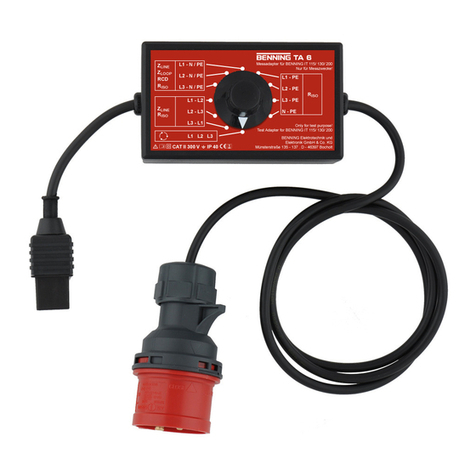
Benning
Benning TA 6 User manual

Benning
Benning IT 130 User manual

Benning
Benning MM 5-2 User manual
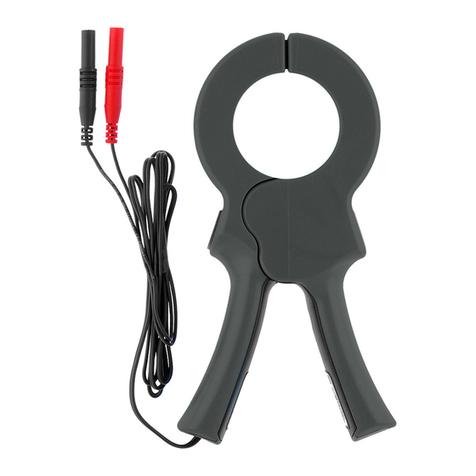
Benning
Benning CC 4-1 User manual
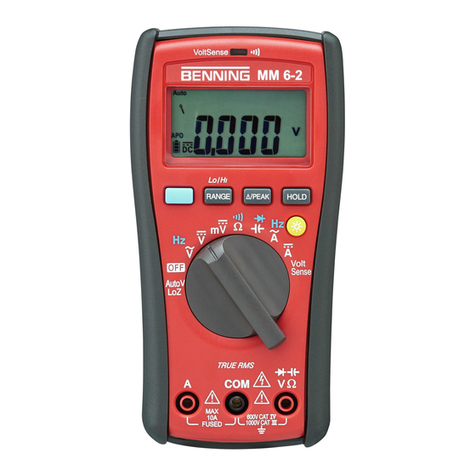
Benning
Benning MM 6-1 User manual
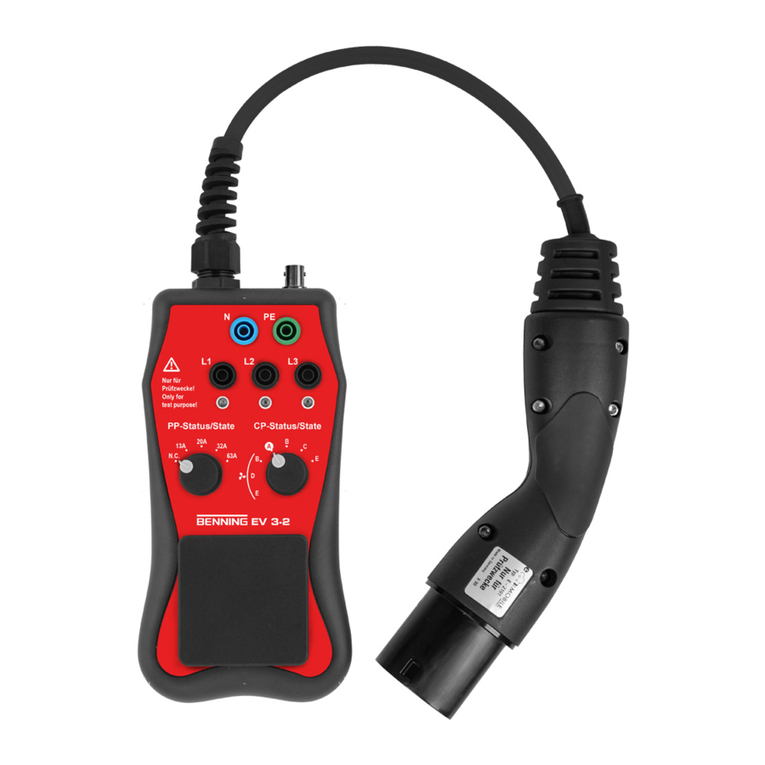
Benning
Benning EV 3-2 User manual

Benning
Benning CM 3 User manual
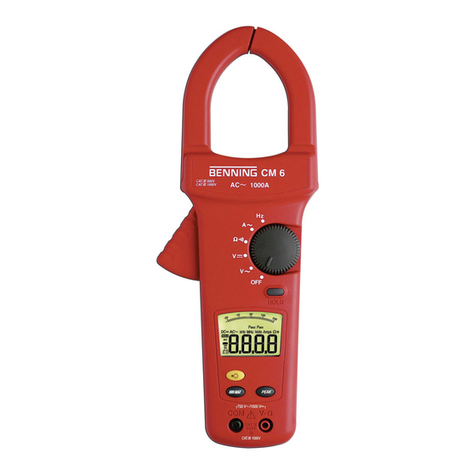
Benning
Benning CM 4 User manual
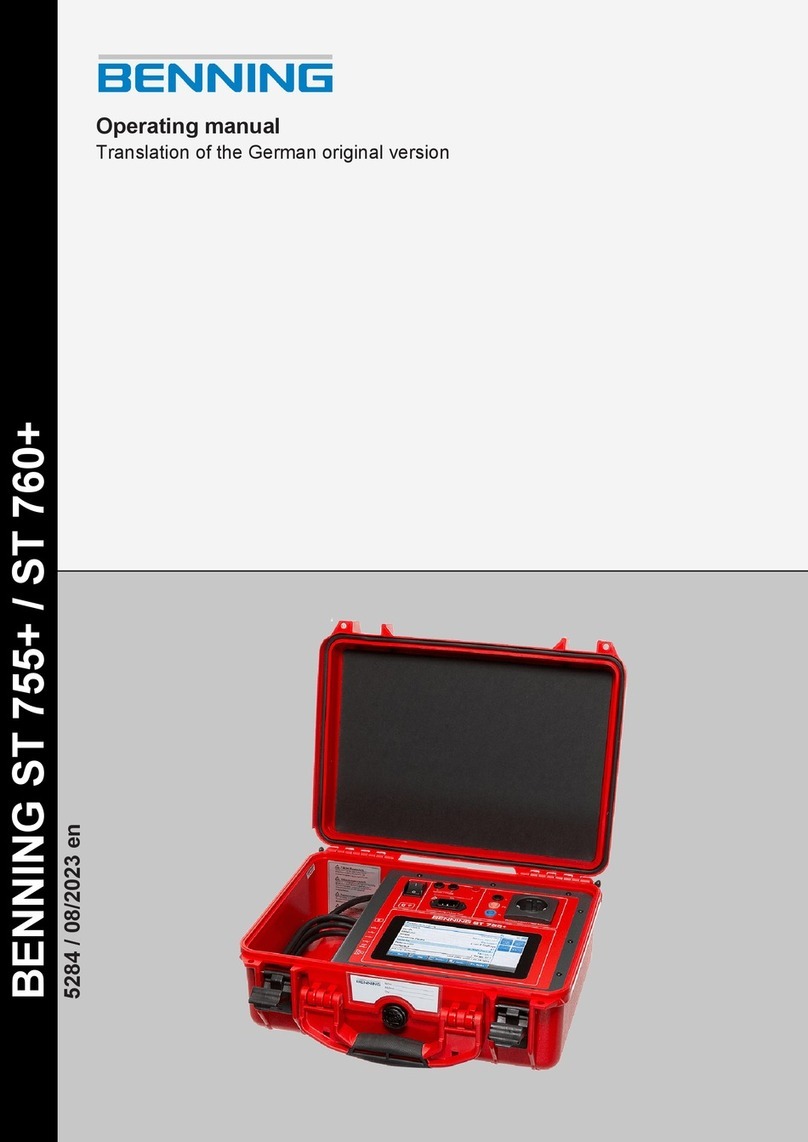
Benning
Benning ST 755+ User manual

Benning
Benning MM 7-2 User manual
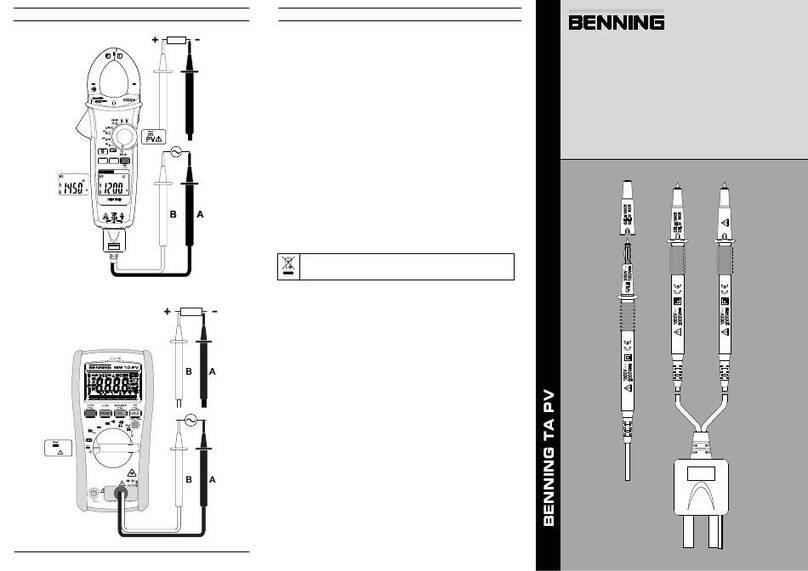
Benning
Benning TA PV User manual
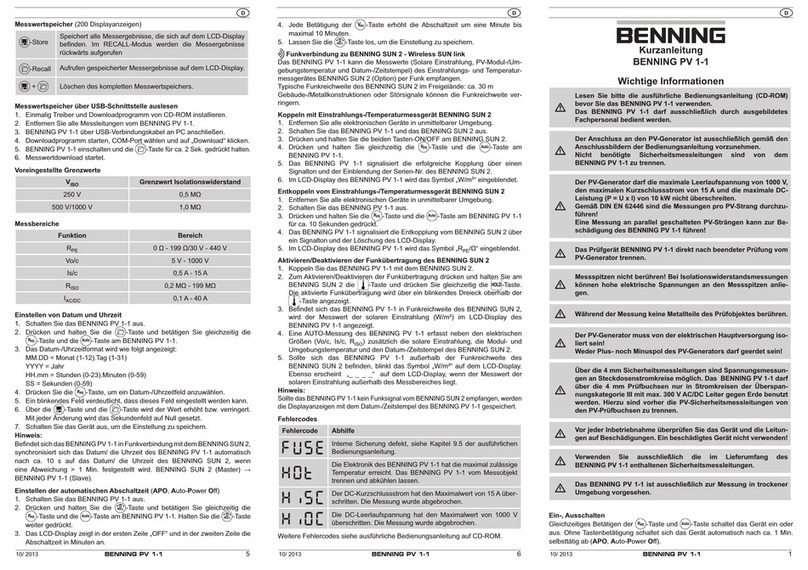
Benning
Benning PV 1-1 Manual
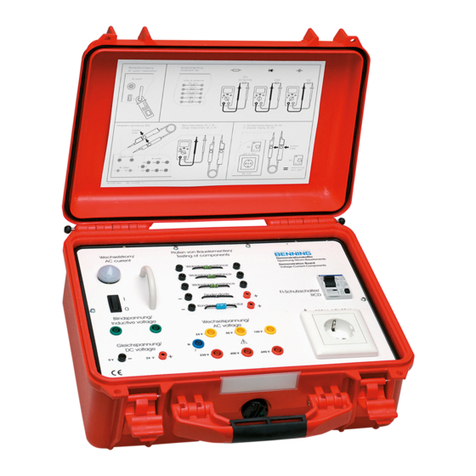
Benning
Benning DB 1 User manual

Benning
Benning IT 100 User manual
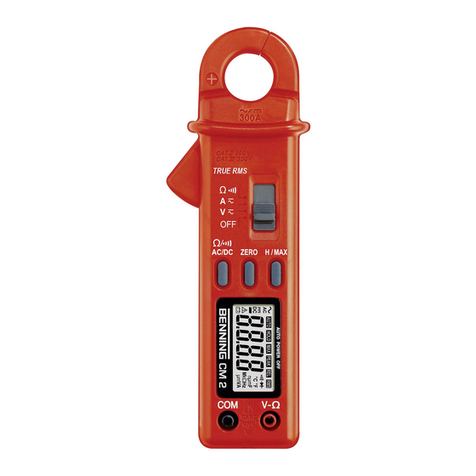
Benning
Benning CM 2 User manual
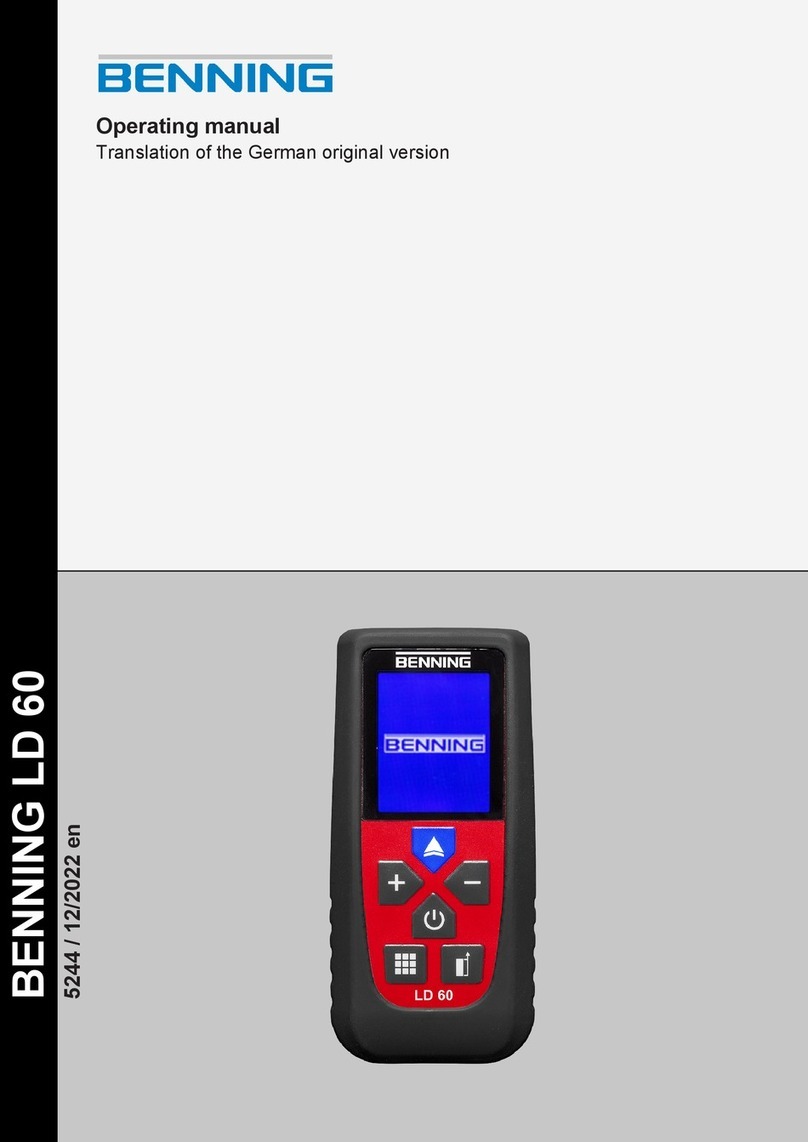
Benning
Benning LD 60 User manual
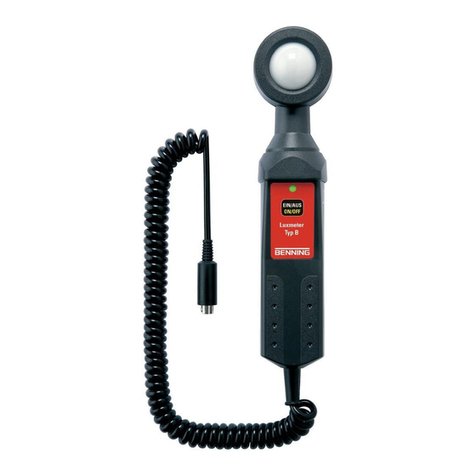
Benning
Benning Luxmeter B User manual
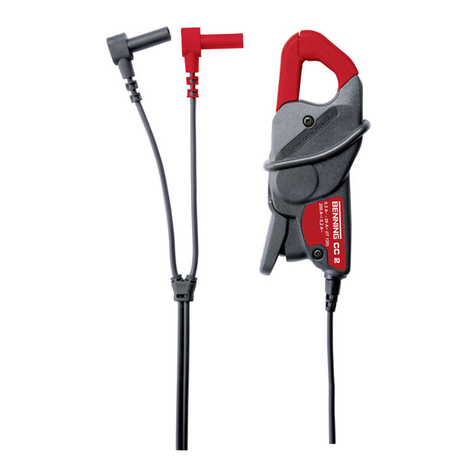
Benning
Benning CC 2 User manual

Benning
Benning ST 725 User manual
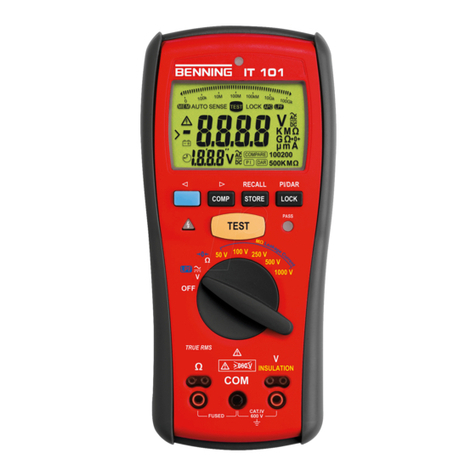
Benning
Benning IT 101 User manual

